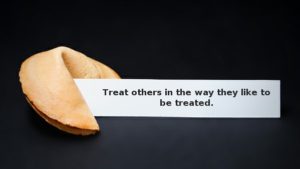 At some point in the workshop I conduct on interpersonal communications skills using the SOCIAL STYLEs model, I invariably make the comment that with the knowledge all of the participants have gained during the session comes great responsibility; that with what they have learned about communication and behaviours comes the responsibility of using that knowledge – they can’t unlearn what they have just learned. In the context of my workshop that means using what is referred to as the “Platinum Rule”, which is to “treat others as they wish to be treated” — the exact opposite of the better-known “Golden Rule” that most of us had drilled into us since we were kids: which is to “treat others how we wish to be treated”.
At some point in the workshop I conduct on interpersonal communications skills using the SOCIAL STYLEs model, I invariably make the comment that with the knowledge all of the participants have gained during the session comes great responsibility; that with what they have learned about communication and behaviours comes the responsibility of using that knowledge – they can’t unlearn what they have just learned. In the context of my workshop that means using what is referred to as the “Platinum Rule”, which is to “treat others as they wish to be treated” — the exact opposite of the better-known “Golden Rule” that most of us had drilled into us since we were kids: which is to “treat others how we wish to be treated”.
The Golden Rule has been taught to us for millennia with the message that if it feels right for me then it must be right for everyone. As I reflect on this it seems that this message might just be one of the reasons why western culture has gotten itself into so much trouble through the ages. It ignores the diversity that surrounds us, not only culturally but even individually. In the context of the workshop I conduct into interpersonal communications there are four basic preferred communication and behaviour styles. The research done by Tracomcorp suggest that the population at large is actually subdivided into these four basic “styles” equally. We should not ignore the fact that our preferred ways of communicating and behaving differ. I’ve been using Tracom’s model for almost 20 years, and my experience has demonstrated that by first understanding your own preferred communications and behaviour style, and then connecting that with an understanding of others’ preferred styles we can and will improve understanding and reduce conflict, which lead to improved performance in the workplace and better communications, period.
The message here for leaders should be obvious. One of the fundamentals of great leadership is to be able to connect with your followers, to build trust. My argument is that to do that effectively as leaders we need to first understand our followers, understand what they need and then move towards their style in the way we communicate with them. This ability to be “versatile” is a skill that most of us need to learn and practice. It can take some time and lot of energy, but in the long term creates huge dividends by way of connecting us with our team, building trust. If you are interested in learning more about how this works and how it can benefit you as a leader, contact me.
This is the eleventh on a series specifically exploring what leadership is and how we can not only understand leadership, but implement it.
Leadership series directory:
Leadership is…. Three Theories of Leadership
Directing, Coaching, Supporting & Delegating Are What?
Who Are K&P and What Is TLC?
Servant Leadership is….
Leadership Style and its Impact
Listening – Leaderships Common Denominator
Intentions and Expectations
Leadership vs Management – Encourager!
The Most Challenging Aspect of Leadership?
Leadership is… About Who We Are Leading
__________________________________________________________________________________________
John Whitehead, coaches’ individuals and organizations in becoming more effective by helping them improve their interpersonal communications, emotional intelligence and resiliency.
*******Are you wondering if having a Leadership/Personal Development Coach is right for you? Contact John for a complimentary, exploratory coaching session at john@johnkwhitehead.ca ********
If you would like to get notifications for when I post, please go to my blog site and register. I promise I will not spam or use your email address for anything else. You can visit and register for my blog at https://johnkwhitehead.ca/blog-2/
